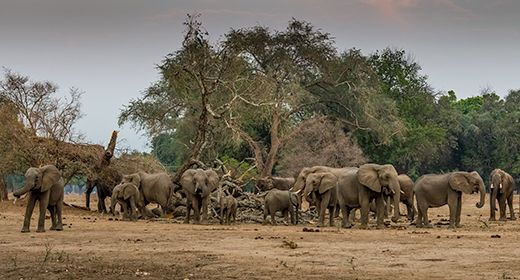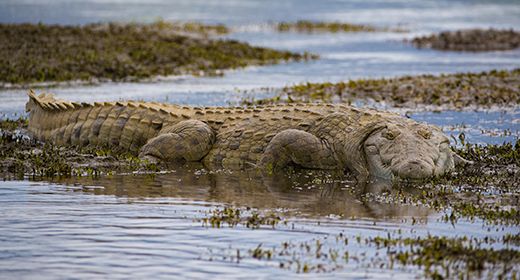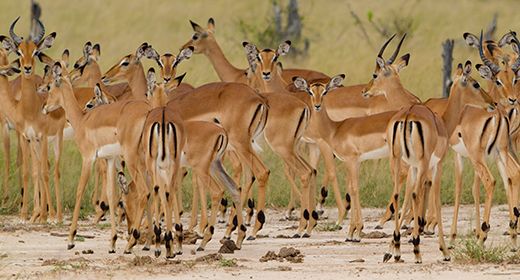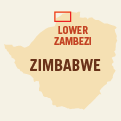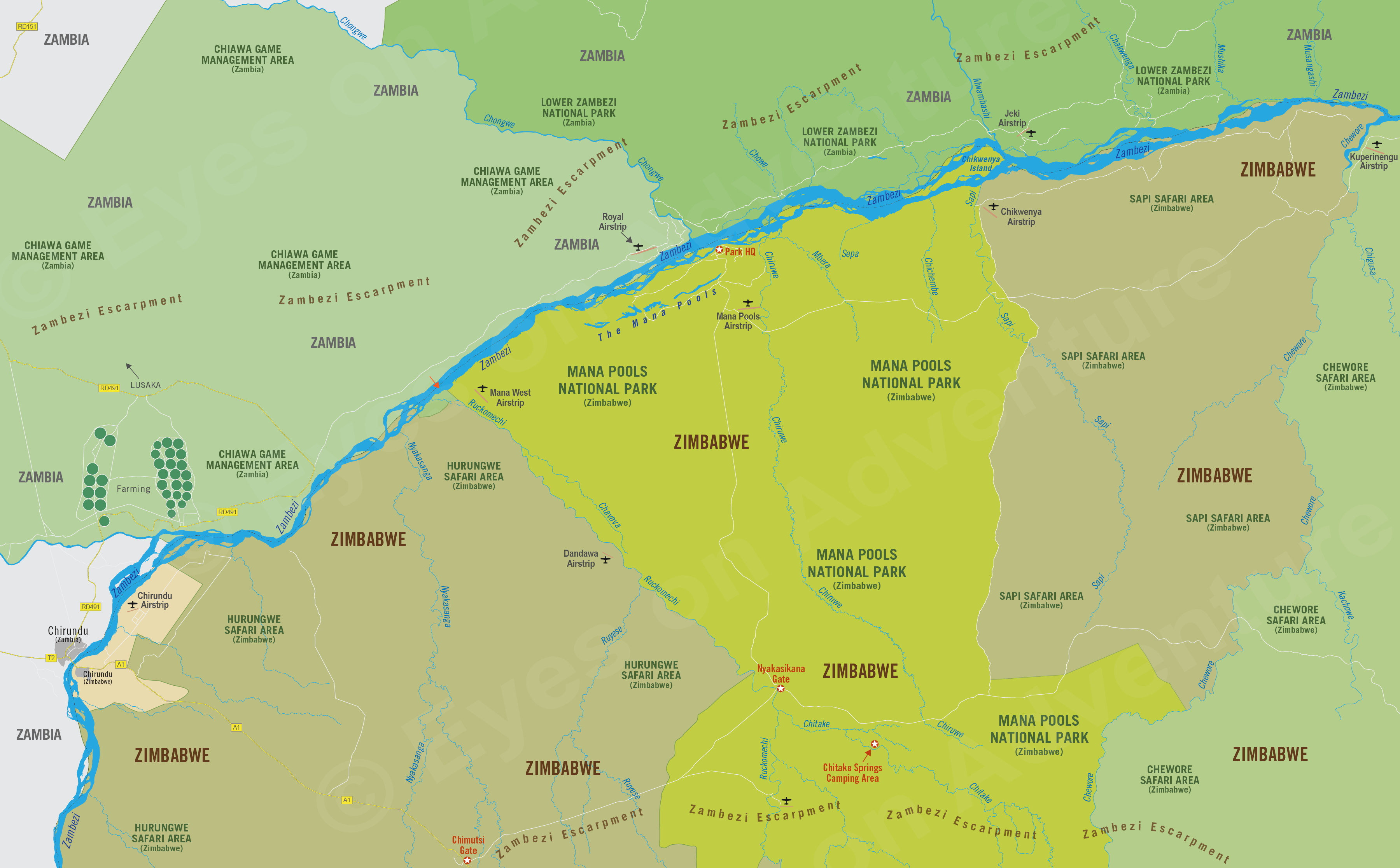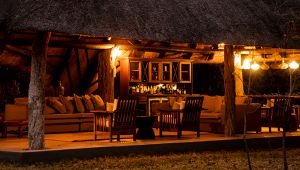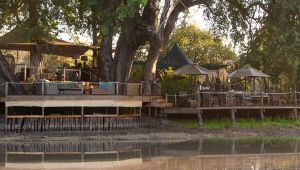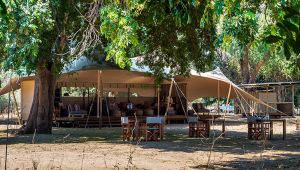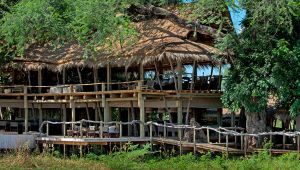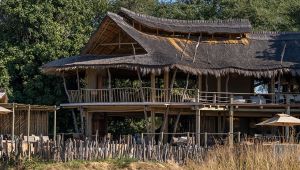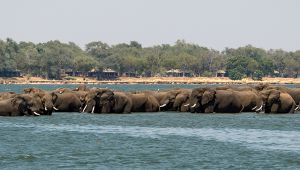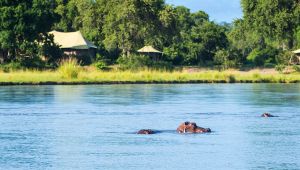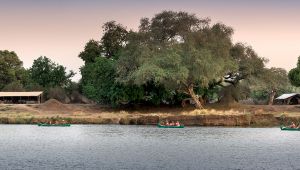Lower Zambezi (Zimbabwe)
(incl. Mana Pools National Park, Sapi Safari Area)
Region Links: Hwange, Lower Zambezi (Zimbabwe), Victoria Falls
Highlights
- The Zambezi River and its floodplains attract big herds and predators.
- Diverse safari activities including game drives, canoeing, and walking.
- Renowned for elephant, buffalo, wild dog, hyena, and large numbers of antelope.
- Very low density of tourists in this UNESCO World Heritage Site.
EOA Recommends: Little Ruckomechi Camp, Nyamatusi Camp, Ruckomechi Camp, Tembo Plains Camp
Zimbabwe's Lower Zambezi is one of Southern Africa's best safari destinations. This remote wildlife haven is located along the Zambezi River and part of a much larger protected area that includes land across the river in Zambia.
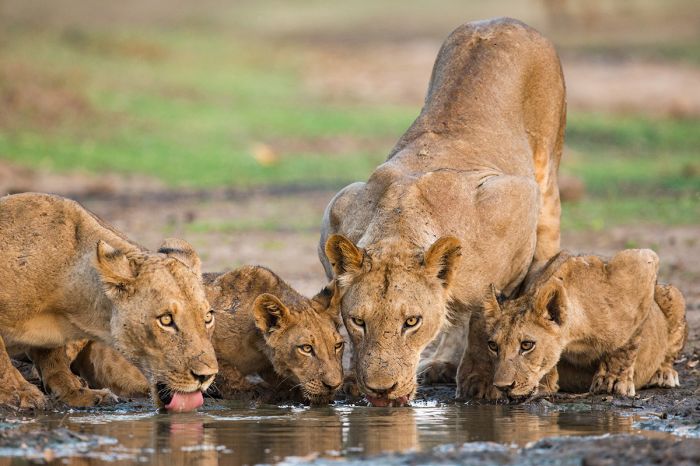
Lions drinking rain water in Mana Pools National Park.
The Zimbabwe portion of the Lower Zambezi region, which includes Mana Pools National Park and the adjoining Sapi and Chewore Safari Areas, was declared a UNESCO World Heritage Site in 1984 and is one of Southern Africa's most diverse wildlife havens. Four of Africa's Big Five species (all but rhino) are here in good numbers, with lion and leopard commonly seen, as well as big herds of buffalo and some of Africa's best elephant viewing.
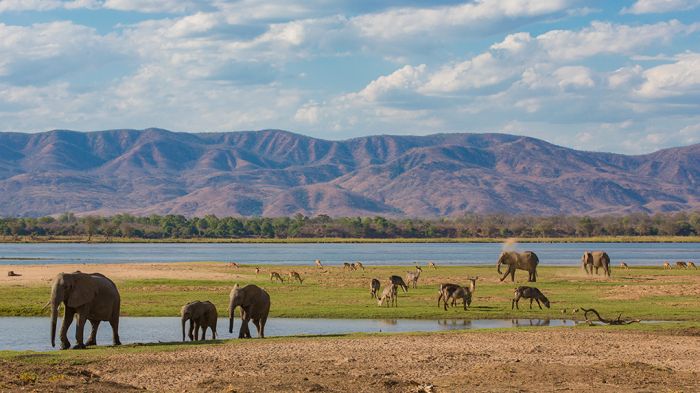
Wildlife on the floodplains along the Zambezi River.
The very low density of camps and lodges means that visitors to the Lower Zambezi will enjoy their safaris in relative exclusivity compared to more typical national parks. Mana Pools NP is one of the few national parks that allow walking safaris and the guides here are renowned as some of the most experienced in Africa.
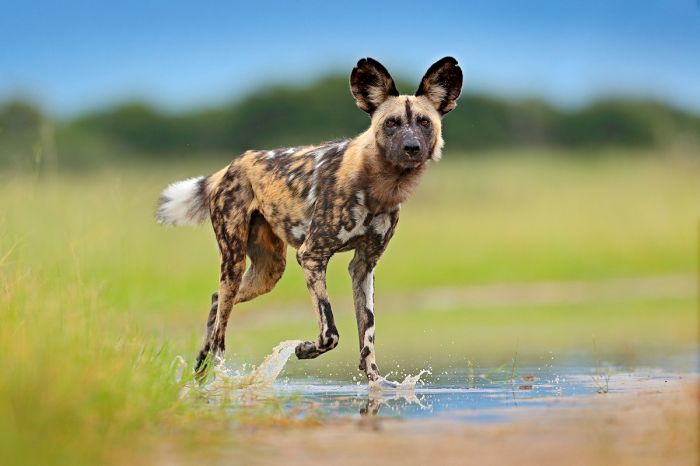
The Lower Zambezi is a great place for seeing African wild dogs.
Canoeing on the Zambezi River, as it flows along the northern border of Zimbabwe, is one of Africa's most incredible safari adventures, offering up close encounters with elephants, hippos, buffalo and more. Canoe safaris are offered as multi-day experiences or as a half-day safari activity from one of the safari lodges.
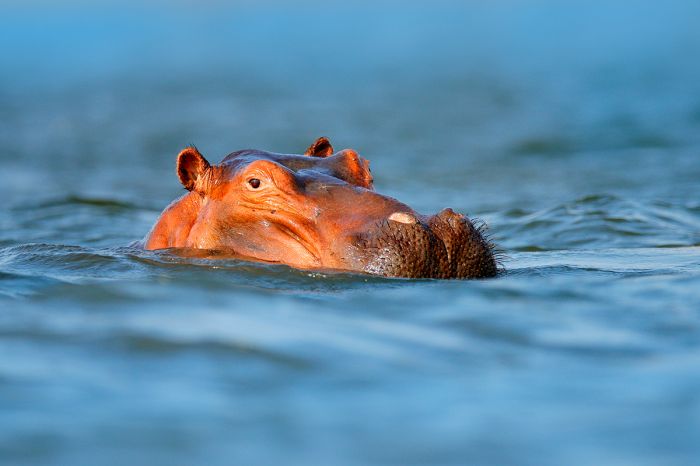
You will see lots of hippos while canoeing on the Zambezi River.
The Lower Zambezi is best visited during the dry, winter months between June and October and some camps are closed during the rainy season between December and March.
Read More...
Activities, Canoeing, Chewore Safari Area, Chitake Springs, Geography, History, Inland Habitats, Mana Pools, Poaching, Sapi Safari Area, Walking Safaris, Wildlife, Zambezi River
History
The Lower Zambezi Valley, which encompasses the lowlands east of the dammed Lake Kariba between the Zambezi Escarpments, has been inhabited by early hominid ancestors for at least two million years. Stone age tools have been found in the region and later, around AD 400, the hunter-gatherer Khoisan (San or Bushman) people arrived in the region.
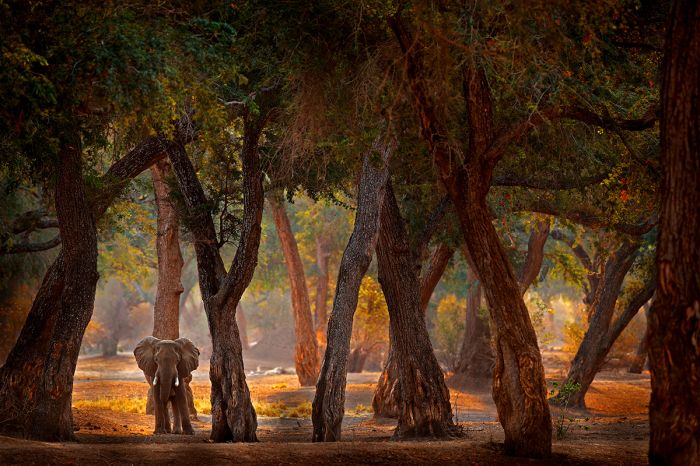
An elephant wanders through a forest in Mana Pools National Park.
Early bushman paintings can be seen in various places in area, including around the headwaters of the Ruckomechi River on the Escarpment. The San later adapted to raising sheep and some cattle. This tribe later became known as the Mbara.
Arab and Portuguese traders used the route of the Zambezi River as a conduit for moving elephant ivory from the Lower Zambezi region to the Indian Ocean going back to the 1500s.
The small towns of Luangwa and Zumbo, located at the confluence of the Zambezi and Luangwa rivers became significant trading centers at this time. The Portuguese and Arabs also captured slaves in the region, which only ceased much later, with the arrival of the British.
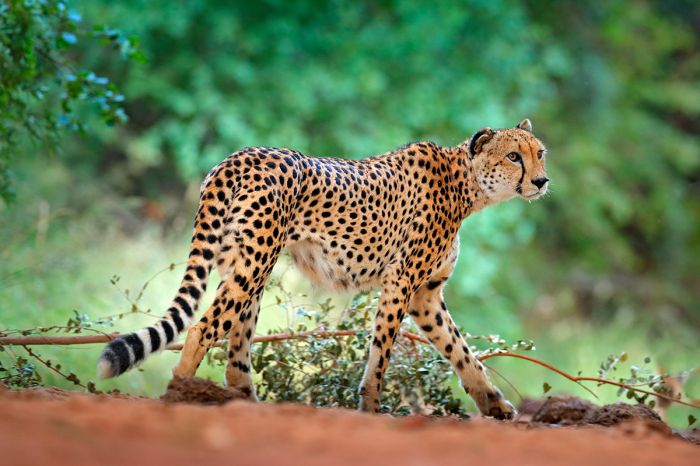
Cheetah are seen on occasion in the Lower Zambezi.
In the mid-1700s, the Shona people arrived to the Zambezi Valley, migrating from the south. Led by Chief Nyambira, the Shona fought and defeated the resident tribes. As is the case throughout much of Southern Africa, the San people were eventually killed or displaced by the more warlike tribe.
Very few people lived in the Zambezi Valley in those days, mostly due to the prevalence of the tsetse fly, which causes sickness in cattle and makes farming nearly impossible. The valley's sparse population subsisted by fishing and growing small grain crops, such as sorghum and rapoko grass.
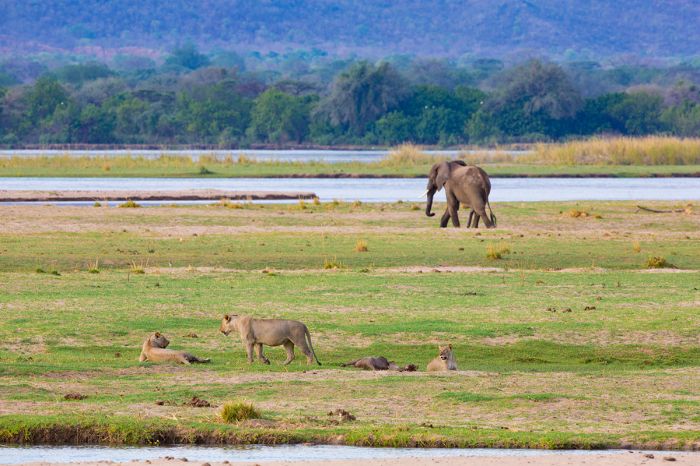
Lions on the Zambezi River floodplain in Mana Pools National Park.
In 1889, Cecil Rhodes and his British South Africa Company (BSAC) negotiated with local chiefs to obtain hunting and mineral rights in the Lower Zambezi Valley on both sides of the Zambezi River, in exchange for British protection. The BSAC focused most of their attention on the lands south of the Zambezi River, and hunting began to seriously decimate the wildlife, especially elephants, which were killed in huge numbers for their ivory.
The famous hunter Frederick Selous was quoted as saying that every year elephants were becoming scarcer south of the Zambezi River, making it impossible to make a living there as a hunter. By the end of the 19th century, elephants had been virtually exterminated south of the Zambezi River.

A leopard in golden grass in Mana Pools National Park.
In 1923, at the request of the BSAC, Britain declared the lands south of the Zambezi (today Zimbabwe) as a self-governing British colony, which they named Southern Rhodesia. The lands north of the river were also annexed by Britain and became Northern Rhodesia (today Zambia).
In the early 1960s, in an effort to stem the rampant over-hunting of the area's wildlife, Southern Rhodesia's government declared that the floodplain land south of the Zambezi extending all the way to the escarpment a "Non-hunting Reserve".
In 1963 it was gazetted as an official Game Reserve. As a result, all people living within the new reserve's boundaries were evicted and moved to lands south of the Zambezi Escarpment.
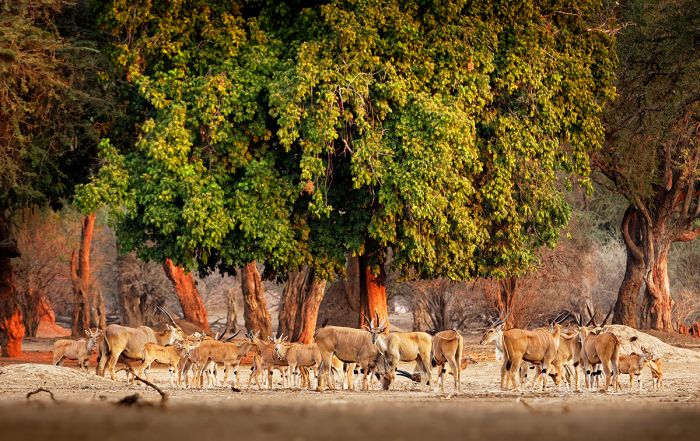
The Lower Zambezi is a good place to see big herds of eland.
In 1964, Northern Rhodesia gained its independence with a black majority rule and became the Republic of Zambia. The predominantly white government in Southern Rhodesia worried the same wave was coming their way and to block a similar transition, declared a Unilateral Declaration of Independence (UDI) from the United Kingdom. The British petitioned the United Nations for sanctions against Rhodesia (Southern Rhodesia was now simply called Rhodesia), which was agreed to.
Civil war broke out in Rhodesia in July 1964, with three separate forces fighting for control of the country: the Rhodesian white minority-led government of Ian Smith, Robert Mugabe's Zimbabwe African National Union (ZANU), and Joshua Nkomo's Zimbabwe African People's Union (ZAPU).
The guerrilla war lasted fifteen years and finally ended with universal suffrage granted in 1979 and the end of the white minority rule in Rhodesia. Elections were held in March 1980, with Robert Mugabe elected as Prime Minister of the new country of Zimbabwe.
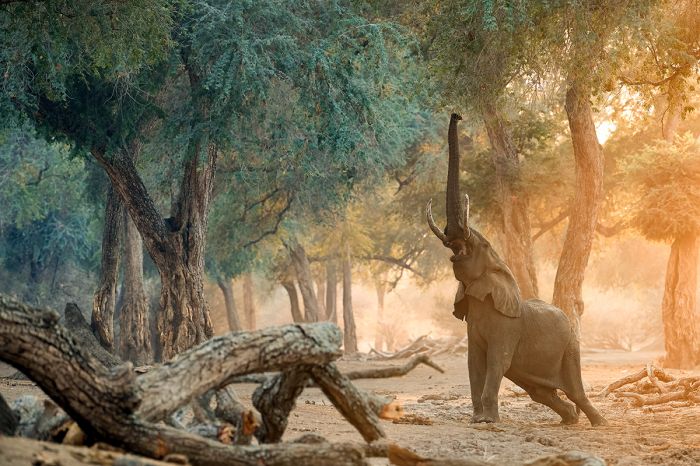
An elephant stretches to reach tasty branches in Mana Pools National Park.
The bush war had deleterious effects on the country's natural areas and tourism suffered with some national parks and tourism destinations closed for safety reasons. Nevertheless, during the conflict, in 1975, Mana Pools was declared a national park. After the country's independence, tourism came back, with visitors once again arriving at Victoria Falls and Zimbabwe's other national parks.
Geography
The Zimbabwe side of the Lower Zambezi is one section of extensive, unfenced natural habitat and wildlife-rich land stretching from Lake Kariba in the west, all the way to the Mozambique border in the east. A large portion of this land, including Mana Pools National Park and the Sapi and Chewore Safari Areas were declared a UNESCO World Heritage Site in 1984. This extensive wilderness is bordered by the Zambezi River on the north and the Zambezi Escarpment, which rises to over 3 300 feet (1 000 meters), on the south, forming one of Africa's most important wildlife regions.
The total area of the World Heritage Site is 2 613 square miles (6 766 sq kms), broken down as follows: Mana Pools NP (848 sq mi/2 196 sq kms); Sapi Safari Area (456 sq mi/1 180 sq kms); Chewore Safari Area (1 309 sq miles/3 390 sq kms).
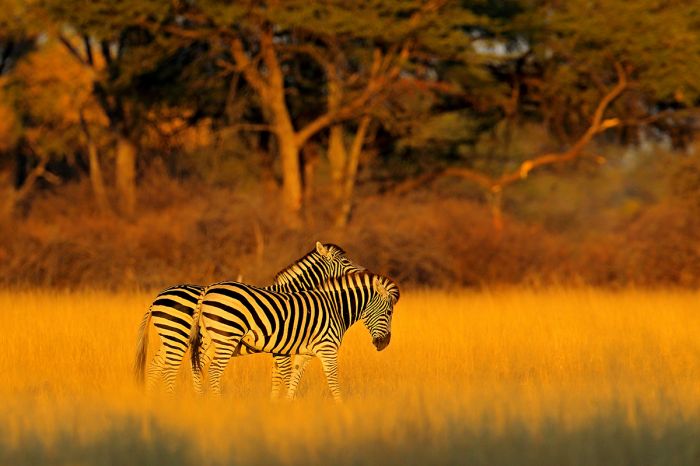
Zebras in Mana Pools.
Zambezi River
The lifeblood of the entire region is the Zambezi River, which begins hundreds of miles away in far northwestern Zambia, flows south through Zambia, turns east where it forms Zambia's southern boundary with Namibia, Botswana, and Zimbabwe, and then flows over The Victoria Falls.
The river continues east to Lake Kariba and finally enters the Lower Zambezi Valley. This valley is bordered on the north and south by steep escarpments, which are an extension of the East African Rift system.
The Zambezi River forms the boundary between Zimbabwe and Zambia and the floodplains on both sides of the river and between the two Zambezi Escarpments are fertile habitat and home to an abundance of wildlife. Directly across the river from Mana Pools are Zambia's Lower Zambezi National Park and Chiawa Game Management Area, which, like Mana Pools, also offer superb wildlife safaris in a protected wilderness.
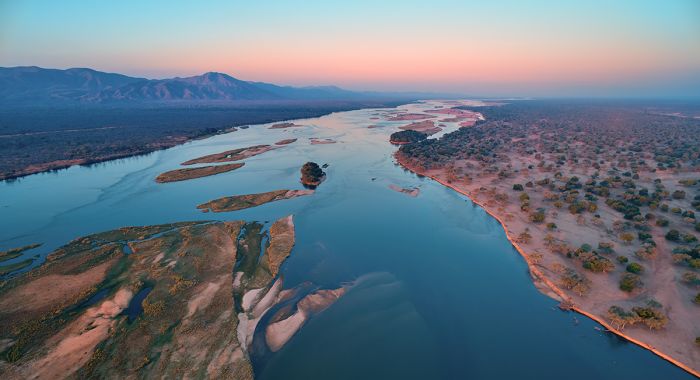
The Zambezi River flowing between Mana Pools (right) and Zambezi NP (left).
The Mana Pools
'Mana' means 'four' in the Shona language and refers to four semi-permanent pools that are remnants of an old course of the Zambezi River. The pools are one of Mana Pools National Park's best locations for wildlife viewing and they are frequently used by large numbers of hippos and crocodiles.
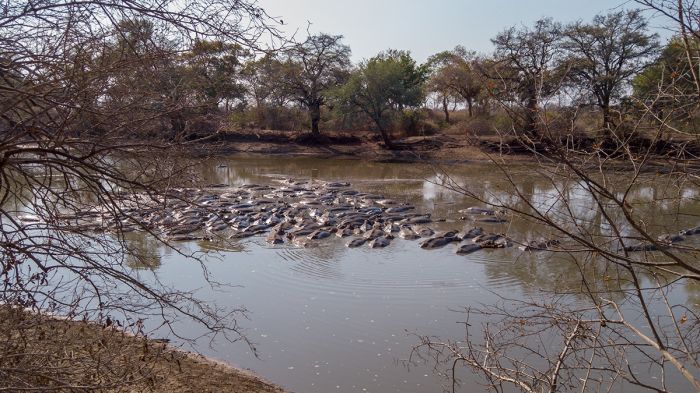
A big group of hippos in one of the 'Mana' pools.
Inland Habitats
Further south and away from the alluvial plains along the Zambezi River, the landscape transitions to a more wooded habitat, with forests of baobab, mopane, sausage, mahogany, fig, and huge Faidherbia albida (commonly called ana or winterthorn) trees.
The ana tree is one of the Lower Zambezi's most recognizable trees, forming beautiful, open-floored woodlands. Their nutritious, indehiscent seed pods are much favored in the spring (July-October) by a variety of animals including elephant, baboon, buffalo, and various antelopes. Dry deciduous thickets of 'jesse bush' (Combretum species) are also common.
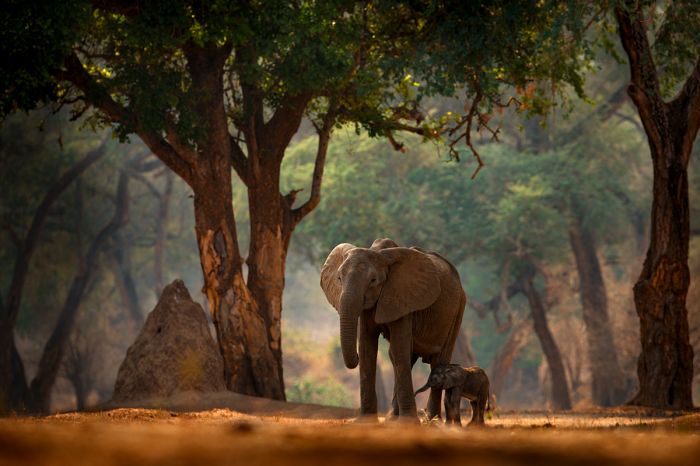
A classic Lower Zambezi scene with an elephant and her calf.
Chitake Springs
Another region of note in the Mana Pools National Park is Chitake Springs, which is located along the escarpment about 30 miles (50 kms) south of the Zambezi River. During the dry season (April-October), this natural spring creates a pool of fresh groundwater spanning about a kilometer along the dry riverbed of the Chitake River.
During the rains (December-March), the Chitake River, which originates in the escarpment, flows into the Ruckomechi River and then into the Zambezi River, but from April onwards, when the rains have ended and the tributary rivers and most water holes have dried up, this natural spring provides a critical water source for an abundance of wildlife.
Wildlife viewing at Chitake Springs, especially during the driest months, can be incredible and it is a popular camping area, with several seasonal bush camps and self-camping sites available.
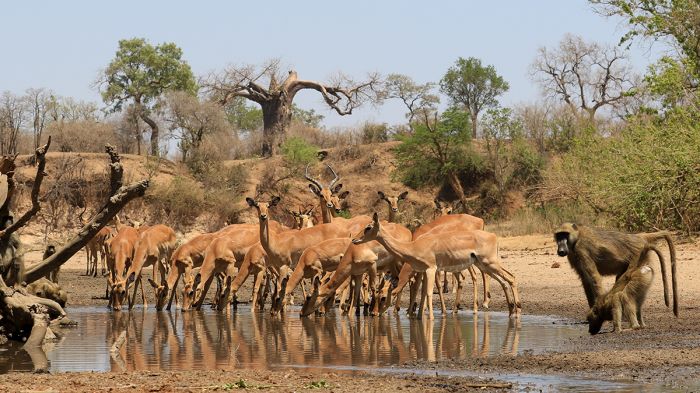
Impalas and baboons drinking at Chitake Springs.
Sapi and Chewore
To the east of Mana Pools are two additional protected areas, the Sapi Wildlife Area and Chewore Safari Area, which together extend almost to the Mozambique border. While Mana Pools gives full protection to all wildlife within its boundaries, Sapi and Chewore allow a mixture of hunting, fishing, and photo safaris.
There are no fences dividing any of these protected areas and some wildlife have learned to avoid the hunting areas, gravitating to the national park instead.
There are some newer safari camps located in Sapi, which is good news, as it means tourism is getting a foothold in this massive wilderness area. Sapi and Chewore offer good wildlife viewing, superb fishing, canoeing, birding.
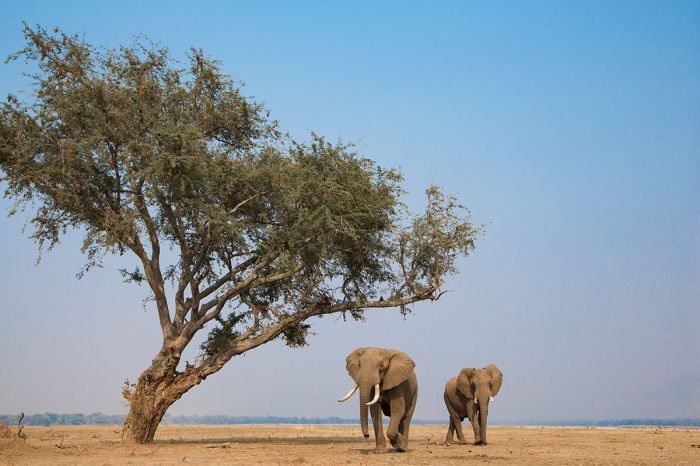
Two elephants feeding on ana tree seed pods.
Wildlife
The Lower Zambezi is renowned for superb wildlife viewing in a remote and uncrowded wilderness that feels untouched by time. Although the black rhino is no longer roaming here, the rest of Africa's Big Five animals - lion, elephant, leopard, and buffalo - are present.
The region is perhaps best known for its elephants, and in particular, its magnificent relaxed bulls, which often walk right through safari camps and campsites. These old bulls have grown used to human presence and provide up close wildlife interactions for visitors. A fascinating sight, which you may see if lucky, is a big bull elephant rearing up on its hind legs to extend its trunk high into a tree to reach tasty branches or seed pods!
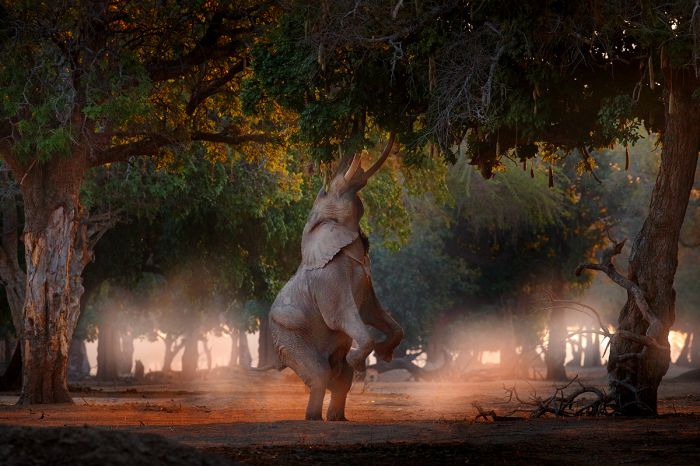
The Lower Zambezi elephants have learned to rear up on two legs to reach food.
Besides the region's impressive elephants, buffalo are found in herds or small groups of old bulls. The buffalo, like elephants, freely cross the Zambezi River into Zambia, often stopping to graze on one of the islands in the river.
Lions are often seen following the large herds of buffalo or waiting at one of the waterholes during the dry season. Leopards are elusive but seen regularly and cheetah are here in small numbers. Spotted hyenas are here in good numbers and are usually seen in small groups.
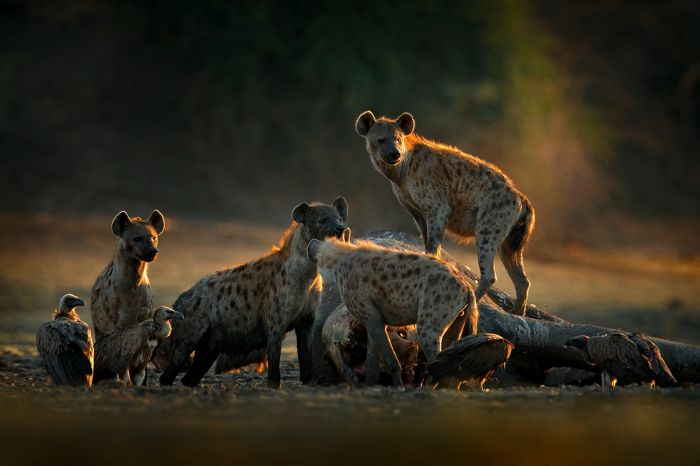
A dead elephant attracts spotted hyenas and vultures in Mana Pools.
African wild dogs are one of the most interesting of Africa's predators and they do well in the Lower Zambezi, with several packs roaming the national park and into the adjoining protected safari areas to the east and west. Packs of these lithe and entertaining predators can often be found hunting along the river at dawn and dusk. Mana is one of the best places in Africa to see wild dogs.
The Lower Zambezi is one of the best places in southern Africa to see sizable herds of eland, Africa's largest antelope. Other herbivores seen regularly includes zebra, impala, waterbuck, greater kudu, bushbuck, and warthog. The shy nyala, which is almost exclusively found only in South Africa's Kruger National Park region, is found here in small numbers. Giraffe are notably absent from Zimbabwe's Lower Zambezi and there are no records that they ever existed here.
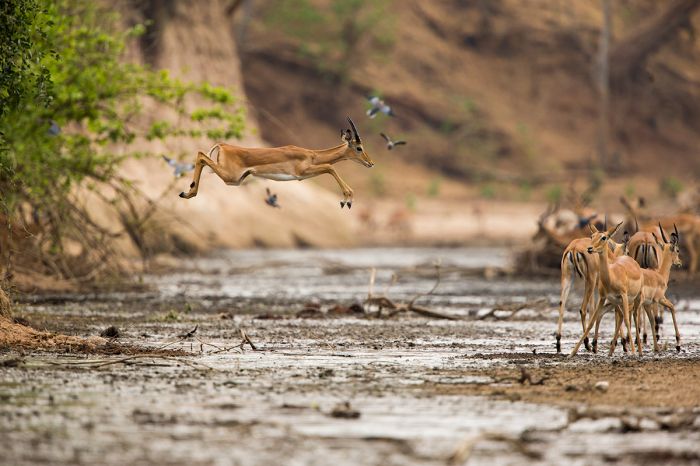
Impalas are very common in the Lower Zambezi.
The lower Zambezi River, which forms the border between Zimbabwe and Zambia, is home to incredible densities of hippo and crocodile. Many 'pods' of hippos live along the banks of the Zambezi River, emerging at night to graze on the floodplain grasses and spending their days sunning on the banks or relaxing in the river's water.
Long Pool, one of the "Mana Pools", is a favorite spot for hippos and crocs and this is a great spot to see huge numbers of both species sunning on the banks of the pool.
Wildlife viewing is best during the dry season months (June-October), when the rain water has evaporated and most waterholes have dried up. At this time, the herds and predators are usually not far from the Zambezi River.
Chitake Springs (read more above) provides a year-round water source for animals well away from the river, making it one of the prime wildlife locations during the dry season.
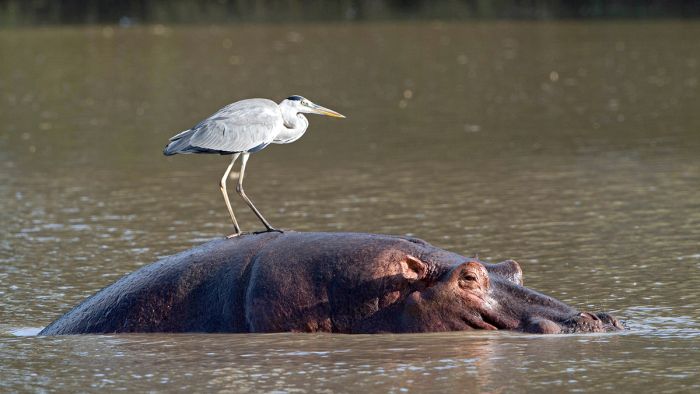
A grey heron hitches a ride atop a hippo in the Zambezi River.
The region's diverse habitats provide for superb bird life, with almost 400 species recorded. Some specials include Lilian's lovebird, Shelley's sunbird, Livingstone's flycatcher, eastern nicator, African pitta, and many more. African skimmers and carmine bee-eaters are often found along the Zambezi River, where both breed and raise their young.
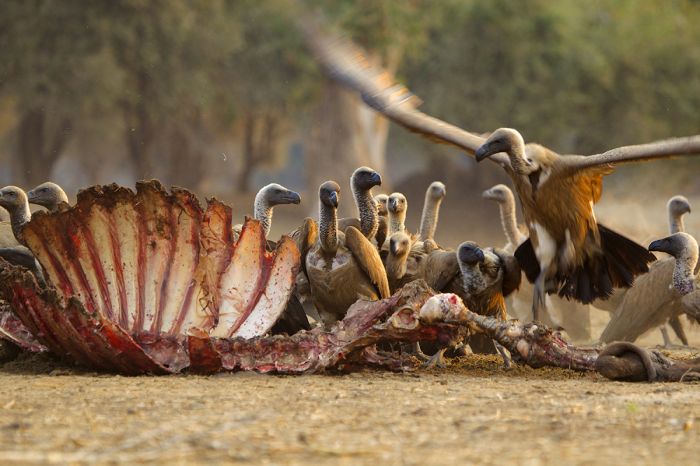
White-backed vultures at the remains of a hippo.
Poaching
Like most of Africa's wildlife destinations, overhunting and poaching, especially of elephants (for their tusks) was rampant in the Lower Zambezi throughout the 19th century. By 1900, it is estimated that only 4 000 elephants remained in Southern Rhodesia (Zimbabwe). Fortunately, the CITES ban on the commercial trade of elephant ivory in 1975 gave these animals a chance to survive again.
The last nationwide census in Zimbabwe (in 2014) showed around 80 000 elephants in the country, of which around 3 000 were living in the Lower Zambezi. However, some illegal hunting still occurs in the Zambezi Valley, and the safari areas outside of the national park do allow controlled commercial hunting.
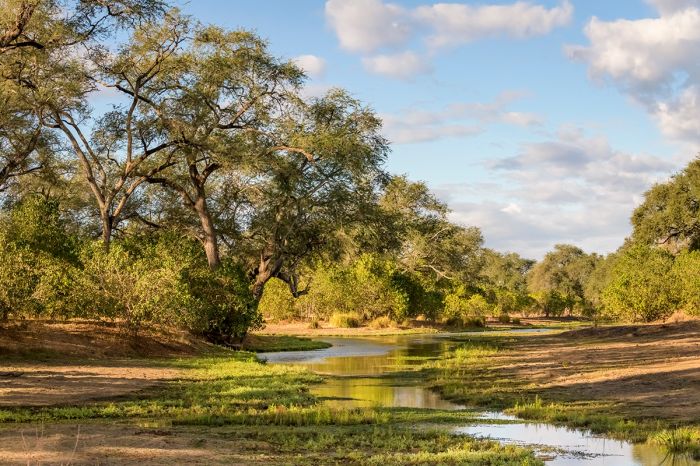
The Lower Zambezi is protected as a World Heritage Site.
In 1984, when the Lower Zambezi region was inscribed as a World Heritage Site, it was one of Africa's most important refuges for the endangered black rhino. At that time, there were an estimated 500 of this iconic species living in the Lower Zambezi Valley. Sadly, over the next 10 years, poaching reduced the black rhino numbers in the valley to just ten individuals, which had to be captured and relocated to protect them. Today, there are no black rhinos remaining here.
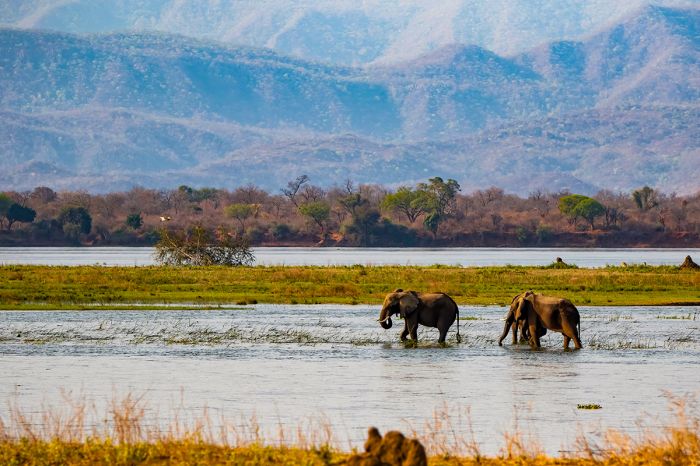
Elephants in the Zambezi River with Zambia on the far bank.
Activities
The Lower Zambezi offers some of Zimbabwe's finest game viewing in a beautiful wilderness far from any substantial human settlement. Its rich and diverse habitats include a long stretch of Zambezi River frontage and the park benefits from a similarly protected wilderness across the river in Zambia.
The options for accommodation range from a very small number of upscale safari lodges, a handful of eco-friendly, seasonal tented camps, and self catering campsites and national park chalets. The very low density of accommodation and tourist numbers make the Lower Zambezi one of southern Africa's most exclusive destinations for wildlife safaris.
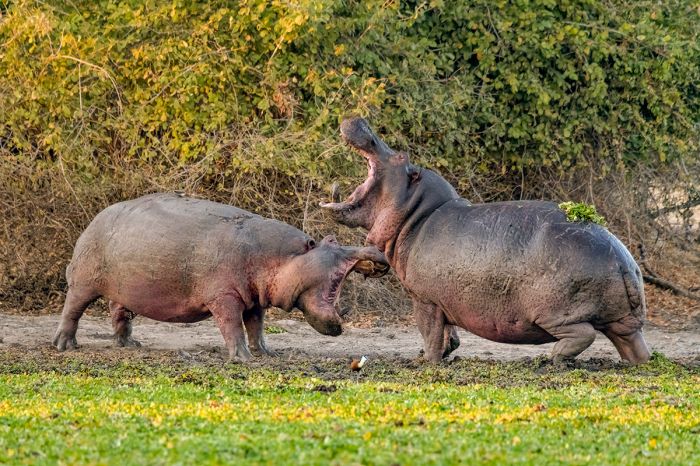
A hippo dispute in Mana Pools NP.
Walking Safaris
Game drives are the most common activity in the Lower Zambezi, but even in the national park, visitors are permitted to walk on their own (only along the floodplains along the river). That said, it is unadvisable to walk without an armed, well-trained guide, as there are substantial numbers of dangerous animals in the region. Most safari camps offer walking safaris and those camping on their own can hire a walking guide at the park headquarters.
The road networks in the national park and adjoining safari areas are minimal, but this is a positive thing for the region's wildlife, as there are huge tracts of land that are only available to wildlife (or to people on foot).
Self-drive visitors are admitted during the dry season (April-October), but during the rains (usually mid-December thru March), many of the roads are too muddy to drive and access to the park away from the river becomes very limited. Besides game drives and walking safaris, limited fishing is permitted, but in the national park, only from land.
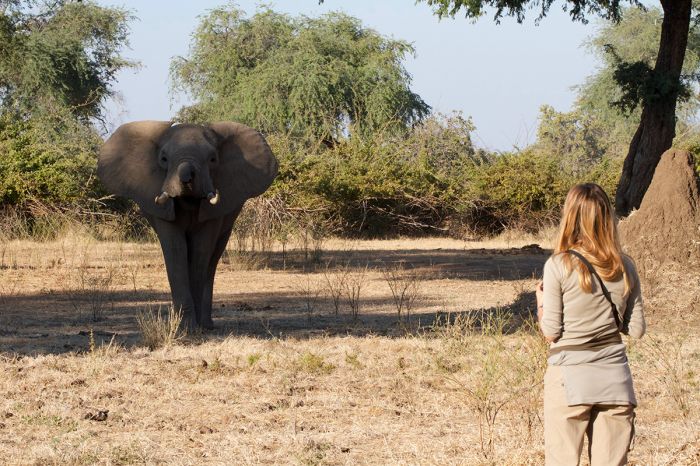
Walking safaris are a popular activity in the Lower Zambezi.
Canoe Safaris
During the dry season months, no motorized boating is permitted on the Zambezi River, but canoeing is a popular activity. The famous multi-day 'Mana Canoe Trail' offers one of Africa's greatest safari adventures, bringing participants up close to a variety wildlife, including elephant, hippo, buffalo, crocodile, and more.
Canoe safari options include the stretch from Kariba to Chirundu (3 days; on the tame side), Chirundu thru Mana Pools (4 days; best game viewing), and Mana Pools to Kanyemba (4 days; wild and untouched- ending on the Mozambique border).
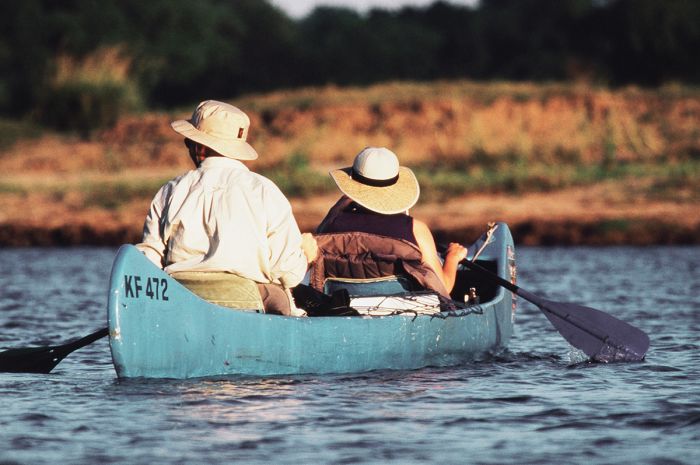
Canoeing on the Zambezi River.
Read More...
Activities, Canoeing, Chewore Safari Area, Chitake Springs, Geography, History, Inland Habitats, Mana Pools, Poaching, Sapi Safari Area, Walking Safaris, Wildlife, Zambezi River
Great Good Fair Poor
- Jan
- Feb
- Mar
- Apr
- May
- Jun
- Jul
- Aug
- Sep
- Oct
- Nov
- Dec
When to Visit
Zimbabwe's Lower Zambezi, like most of Southern Africa, has distinct seasons defined primarily by rain. Temperatures are mild to hot year-round. The summer/rainy season runs from around mid-November thru mid-April, and many of the safari camps are closed or have limited activities at this time. The winter/dry season (Jun-Oct) is the best time to visit the Lower Zambezi for wildlife viewing.
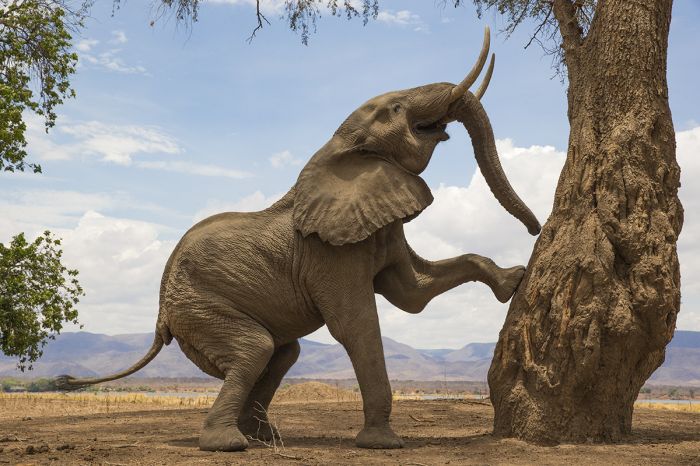
A bull elephant prepares to reach high for its food in the Lower Zambezi.
Winter / Dry Season
The dry season in the Lower Zambezi and Mana Pools runs from May thru October, with almost zero precipitation during this period. The wildlife viewing is at its best in winter, with herds of elephant, buffalo, and antelope congregating along the permanent waters of the Zambezi River. Ground water dries up inland from the river except at Chitake Springs, which offers superb game viewing at this time as well.
The dry season is unsurprisingly the peak tourist season, but the low density of safari camps in Mana means that it never feels like there are a lot of visitors.
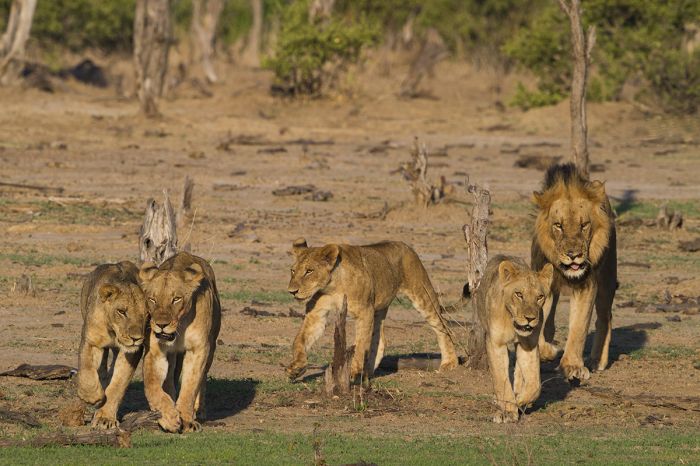
Lions in Mana Pools National Park.
May is the start of the dry, winter season, but vegetation still retains its lush greenery from the months of summer rains. Some late rains may fall, but most days are clear and sunny. Temps during the day average a pleasant 73-77°F (23-25°C) with overnight lows averaging 49-51°F (9-11°C).
June and July are the coldest months and experience no rain. The bush is transforming from green to brown and the temperatures are warm during the day and cool at night. Daytime temps reach an average of 75-78°F (24-26°C), but the early mornings are quite chilly and open-air game drives will require a warm outer layer. Overnight temps drop to an average of 47-51°F (8-10°C). The game viewing, especially around water sources is very good.
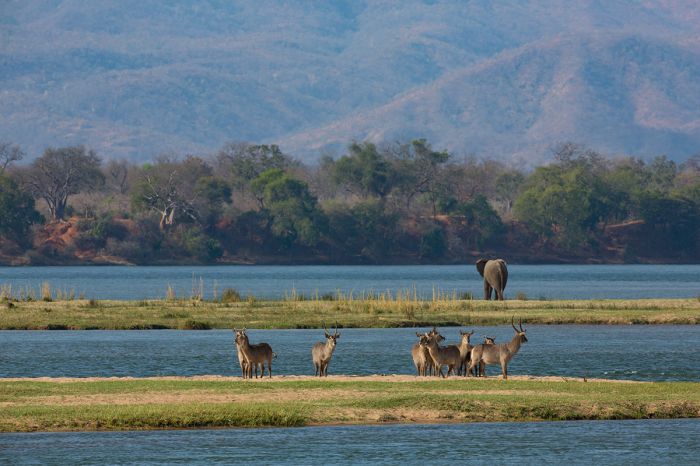
The floodplains along the Zambezi River are excellent for wildlife.
August and September are exceptionally great months to visit the Lower Zambezi. The game viewing is at its very best, especially along the Zambezi River and at Chitake Springs, as all other water sources are now completely dried. Most grass and other vegetation is very dry and the floodplains along the river are teeming with life. The springtime temperatures are rising, with midday temps reaching highs of 86-91°F (30-33°C) and nights and early mornings only falling to a pleasant 55-63°F (13-17°C).
October is the hottest and driest month until the first early rains occur, which can be at the end of the month in some years. Wildlife viewing is outstanding at the river and at Chitake, but the temperatures can mean safari activities are shorter to avoid the intense heat. Midday temps can reach highs of 93-98°F (34-37°C) and even the nights are warm, only dropping to 66-69°F (19-21°C).
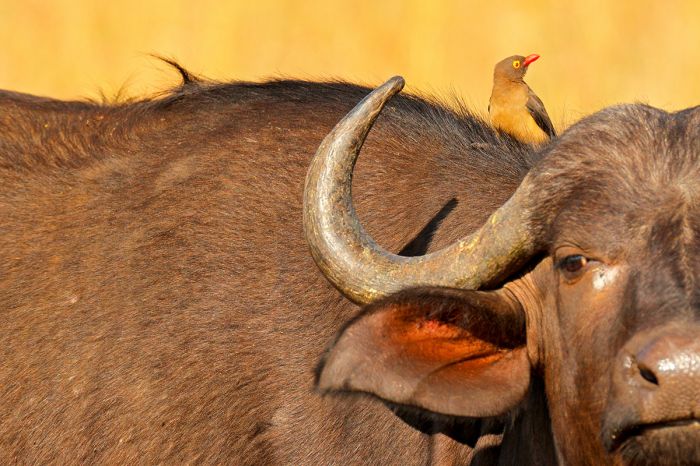
A red-billed oxpecker atop a buffalo.
Summer / Rainy Season
The Lower Zambezi summer is from November thru April and this is when the region experiences rainfall. Early rains can arrive at the end of October, which brings welcome relief after the long dry winter. The early part of the season is still a good time to visit, with lots of baby impalas and other herbivores born when the grasses are becoming rich. Some roads in the park become very difficult as the season progresses and rains increase. Some safari camps may close during the rains.
November is the start of the rainy season and the landscape transforms from dry and dusty into a beautiful and verdant environment. Rains in November typically only fall every other day and are not all-day events. Temperatures are very warm, with daytime temps reaching 88-92°F (31-33°C), but afternoon showers cool things down a bit when they come. Temps fall to around 64-67°F (18-19°) overnight.
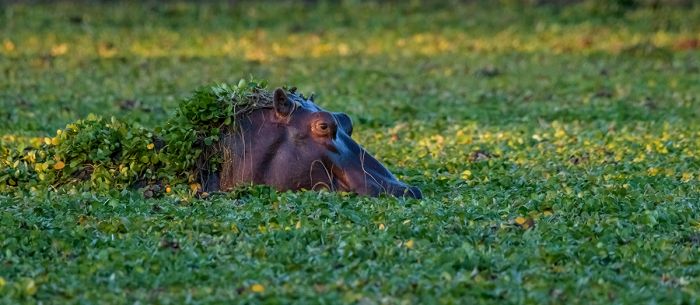
A hippo enjoying the new rain water in Mana Pools.
December thru February experience the highest rainfall in the Lower Zambezi and some of the safari camps are closed. Daily rainfall is the norm, but showers do not usually last all day. The safari roads in the park can become extremely difficult at this time, which can interfere with safari activities.
March is still considered a rainy month, but rainfall is decreasing in volume and frequency. Temperatures are roughly the same as in December-February and the wildlife is still widely dispersed.
The park's smaller rivers, which are dry during the winter, are flowing and wildlife disperses away from the Zambezi River and towards the escarpment, making game viewing somewhat more challenging. Midday temps average 82-88°F (28-31°C), dropping to 64-70°F (18-21°C) at night.
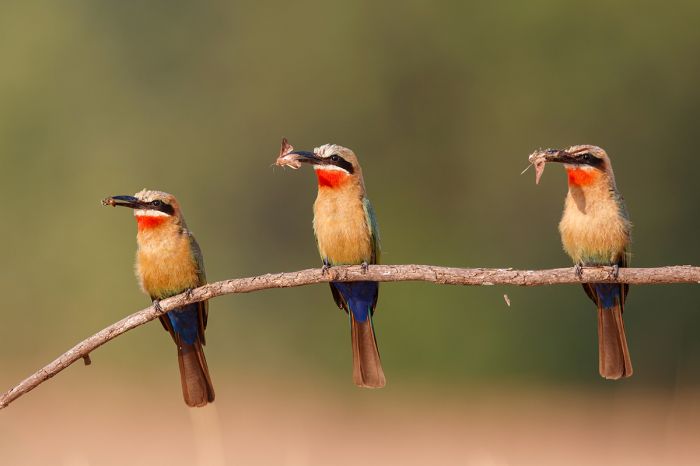
White-fronted bee-eaters in the Lower Zambezi.
April is a transition month between the rains and the coming dry season. Rainfall is slowing and sporadic and the landscape is lush and thick. This is a very pleasant time to visit, but some roads may still be difficult. Temps during the day reach 84-86°F (29-30°C), while overnight/early morning temps are a comfortable 51-54°F (10-12°C).
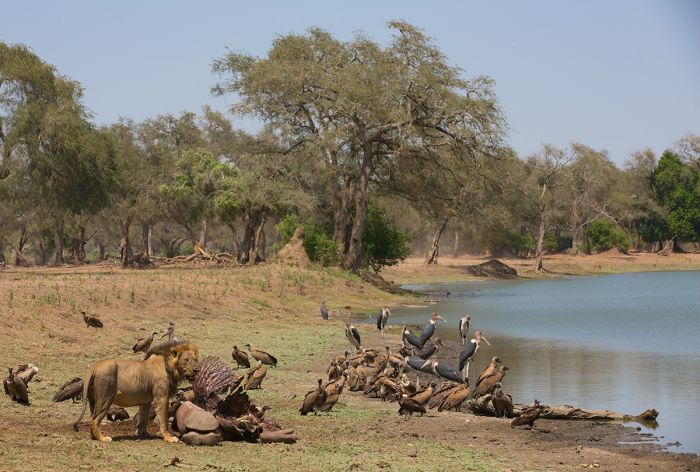
Lions, vultures, and storks at a hippo carcass along the Zambezi River.
Showing 1–8 of 8 results
Located in the spectacular Lower Zambezi region, the camp literally borders Mana Pools National Park and lies within an UNESCO World Heritage Site. Seasonally superb wildlife viewing via game driving, boating, and walking.…
Seasonal camp with a wildlife waterhole that is the only drinking spot for many miles during the dry season. No other camps nearby, providing a very exclusive experience. Very good wildlife viewing, game drives, walking safaris, and 'arm-chair' safaris from the camp.…
Little Ruckomechi is a small (4 tents) camp located in the spectacular Lower Zambezi region in a private concession adjoining Mana Pools National Park. Seasonally superb wildlife viewing via game driving, boating, and walking.…
Lovely camp located in the core area of Mana Pools National Park along the Zambezi River. No other camps nearby, providing a very exclusive experience. Superb wildlife viewing, game drives, walking safaris, canoeing, fishing, and seasonal boating.…
Family-friendly and no other camps nearby, providing a very exclusive experience. Located in the central portion of Mana Pools National Park on the Zambezi River. Abundant and diverse wildlife, game drives, walking safaris, canoeing, fishing, and seasonal boating.…
Located in the spectacular Lower Zambezi region in a private concession adjoining Mana Pools National Park. Seasonally superb wildlife viewing via game driving, boating, and walking.…
Located in the wildlife-rich Lower Zambezi within in a private concession adjoining Mana Pools National Park. Offers a true wilderness experience with no other camps for many miles. Very good wildlife viewing via game driving, boating, canoeing, and walking.…




